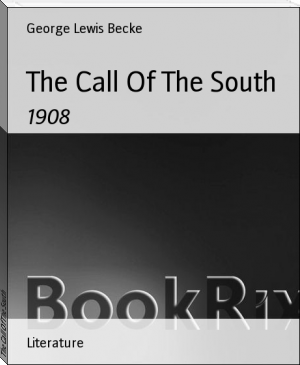The Call Of The South, George Lewis Becke [best management books of all time txt] 📗

- Author: George Lewis Becke
Book online «The Call Of The South, George Lewis Becke [best management books of all time txt] 📗». Author George Lewis Becke
On the north coast of Upolu there is a populous town and district named Fasito'otai. It is part of the A'ana division of Upolu, and is noted, even in Samoa, a paradise of Nature, for its extraordinary fertility and beauty.
The A'ana people at this time were suffering from the tyranny of Manono, a small island which boasted of the fact of its being the birthplace and home of nearly all the ruling chiefs of Samoa, and the extraordinary respect with which people of chiefly lineage are treated by Samoans, generally led them to suffer the greatest indignities and oppressions by the haughty and warlike Manonoans, who exacted under threats a continuous tribute of food, fine mats and canoes. Finally, a valorous young chief named Tausaga--though himself connected with Manono--revolted, and he and his people refused to pay further tribute to Manono, and a bloody struggle was entered upon.
For some months the war continued. No mercy was shown on either side to the vanquished, and there is now a song which tells of how Palu, a girl of seventeen, with a spear thrust half through her bosom by her brother-in-law, a chief of Manono, shot him through the chest with a horse pistol, and then breaking off the spear, knelt beside the dying man, kissed him as her "brother" and then decapitated him, threw the head to her people with a cry of triumph--and died.
At first the A'ana people were victorious, and the haughty Manonoans were driven off into their fleets of war canoes time and time again. Then Manono made alliance with other powerful chiefs of Savai'i and Upolu against A'ana, and two thousand of them, after great slaughter, occupied the town of Fasito'otai, and the A'ana people retired to inland fortresses, resolved to fight to the very last Among the leaders of the defeated people were two white men--an Englishman and an American--whose valour was so much admired, even by the Manono people, that they were openly solicited to desert the A'ana people, and come over to the other side, where great honours and gifts of lands awaited them. To their credit, these two unknown men rejected the offer with scorn, and announced their intention to die with the people with whom they had lived for so many years. At their instance, many of the Manono warriors who had been captured had been spared, and kept prisoners, instead of being ruthlessly decapitated in the usual Samoan fashion, and their heads exhibited, with much ignominy, from one village to another, as trophies.
For two years the struggle continued, the Manonoans generally proving victorious in many bloody battles. Then Fasito'otai was surprised in the night, and two-thirds of its defenders, including many women and children, slaughtered. Among those who died were the two white men. They fell with thirty young men, who covered the retreat of the survivors of the defending force.
The extraordinary valour which the A'ana people had displayed, exasperated the Manono warriors to deeds of unnamable violence to whatever prisoners fell into their cruel hands. One man--an old Manono chief--who had taken part in the struggle, told me with shame that he saw babies impaled on bayonets and spears carried exultingly from one village to another.
Broken and disorganised, the beaten A'ana people dispersed in parties large and small. Some sought refuge in the mountain forests, others put to sea in frail canoes, and mostly all perished, but one party of seventeen in three canoes succeeded in reaching Uea (Wallis Island), three hundred miles to the westward of Samoa Among them was a boy of seven years of age, who afterwards sailed with me in a labour vessel. He well remembered the horrors of that awful voyage, and told me of his seeing his father "take a knife and open a vein in his arm so that a baby girl, who was dying of hunger, could drink".
Relentless in their hate of the vanquished foe, the Manono warriors established a cordon around them from the mountain range that traverses the centre of Upolu to the sea, and at last, after many engagements, drove them to the beach, where a final battle was fought. Exhausted, famine-stricken, and utterly disheartened by their continuous reverses, the unfortunate A'ana people were easily overcome, and the fighting survivors surrendered, appealing to their enemies to at least spare the lives of their women and children.
But no mercy was shown. As night began to fall, the Manonoans began to dig a huge pit at a village named Maota, a mile from the scene of the battle, and as some dug, others carried an enormous quantity of dead logs of timber to the spot. By midnight the dreadful funeral pyre was completed.
In case that it might be thought by my readers that I am exaggerating the horrors of "The Pit of Maota," I will not here relate what I, personally, was told by people who were present at the awful deed, but repeat the words of Mr. Stair, an English missionary of the London Missionary Society, whose book, entitled Old Samoa, tells the story in quiet, yet dramatic language, and although in regard to some minor details he was misinformed, his account on the whole is correct, and is the same as was told to me by men who had actually participated in the tragedy.
The awful preparations were completed, and then the victors, seizing those of their captives who were bound on account of their strength and had a few hours previously surrendered, hurried them to the fatal pit, in which the huge pile of timber had been lit. And as the flames roared and ascended, and the darkness of the surrounding forest was made as light as day, the first ten victims of four hundred and sixty-two were cast in to burn, amid the howls and yells of their savage captors.
Mr. Stair says: "This dreadful butchery was continued during one or two days and nights, fresh timber being heaped on from time to time, as it was with difficulty that the fire could be kept burning, from the number of victims who were ruthlessly sacrificed there.
"The captives from Fasito'otai were selected for the first offerings, and after them followed others in quick succession, night and day, early and late, until the last wretched victim had been consumed. Most heartrending were the descriptions I received from persons who had actually looked on the fearful scenes enacted there.
"Innocent children skipped joyfully along the pathway by the side of their conductors and murderers,{*} deceived by the cruel lie that they were to be spared, and were then on their way to bathe; when suddenly the blazing pile (in the Pit of Noata) with the horrid sight of their companions and friends being thrown alive into the midst, told them the dreadful truth; whilst their terror was increased by the yells of savage triumph of the murderers, or the fearful cries of the tortured victims which reached their ears."
* I was told that the poor children were led away as they
thought to be given si mea ai vela--"something hot" (to
eat).--[L.B.]
When I first saw the dreadful Tito (pit) of Moata, it was at the close of a calm, windless day. I had been pigeon-shooting in the mountain forest, and was accompanied by a stalwart young Samoan warrior. As we were returning to Fasito'otai, he asked me if I would come a little out of the way and look at the "Tito," a place he said "that is to our hearts, and is, holy ground". He spoke so reverently that I was much impressed.
Following a winding path we suddenly came in view of the pit. The sides were almost covered with many beautiful varieties of crotons, planted there by loving hands, and it was very evident to me that the place was indeed holy ground. At the bottom of the pit was a dreadful reminder of the past--a large circle of black charcoal running round the sides, and enclosing in the centre a large space which at first I thought was snow-white sand, but on descending into the pit with uncovered head, and looking closer, found it was composed of tiny white coral pebbles. Hardly a single leaf or twig marred the purity of the whiteness of the cover under which lay the ashes of nearly five hundred human beings. Every Saturday the women and children of Fasito'otai and the adjacent villages visited the place, and reverently removed every bit of _debris_, and the layer of stones, carefully selected of an equal size, was renewed two or three times a year as they became discoloured by the action of the rain. Encompassing the wooded margin of the pit were numbers of orange, lime and banana trees, all in full fruit. These were never touched--to do so would have been sacrilege, for they were sacred to the dead. All around us were hundreds of wood-doves and pigeons, and their peaceful notes filled the forest with saddening melody. "No one ever fires a gun here," said my companion softly, "it is forbidden. And it is to my mind that the birds know that it is a sacred place and holy ground."
CHAPTER XXII ~ VANAKI, THE STRONG SWIMMER
On the afternoon of the 4th of June, 1885, the Hawaiian labour schooner _Mana_, of which I was "recruiter" was beating through Apolima Straits, which divide the islands of Upolu and Savai'i. The south-east trade was blowing very strongly and a three-knot current setting against the wind had raised a short, confused sea, and our decks were continually flooded. But we had to thrash through it with all the sail we could possibly carry, for among the sixty-two Gilbert Islands "recruits" I had on board three had developed symptoms of what we feared was small-pox, and we were anxious to reach the anchorage off the town of Mulifanua at the west end of Upolu before dark. At Mulifanua there was a large German cotton plantation, employing four hundred "recruited" labourers, and on the staff of European employes was a resident doctor. In the ordinary course of things we should have gone on to Apia, which was twenty miles farther on, and our port of destination, and handed over my cargo of "recruits" to the manager of the German firm there; but as Mulifanua Plantation was also owned by them, and my "recruits" would probably be sent there eventually, the captain and I decided to land the entire lot at that place, instead of taking them to Apia, where the European community would be very rough upon us if the disease on board did turn out to be small-pox.
As the skipper and I were standing aft, watching the showers of spray that flew over the schooner every time a head sea smacked her in the face, one of the hands shouted out that there was a man in the water, close to on the weather bow. Hauling our head sheets to windward we head-reached towards him, and in a few minutes the man, who was swimming in the most gallant fashion, was alongside, and clambered on board. He was a rather dark-skinned Polynesian, young, and of extremely powerful physique.
"Thanks, good friends," he said, speaking in halting Samoan. "'Tis a high sea in which to swim. Yet," and here he glanced around him at the land on both sides, "I was half-way across."
"Come below," I said, "and take food and





Comments (0)